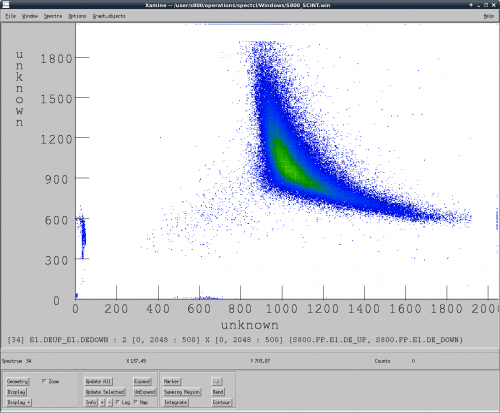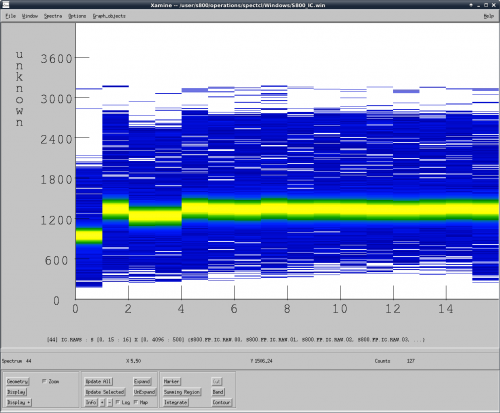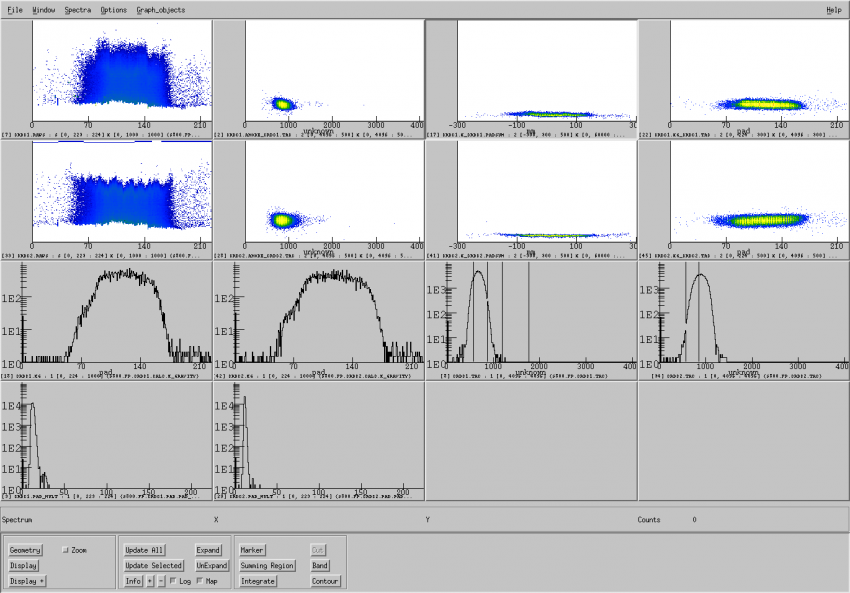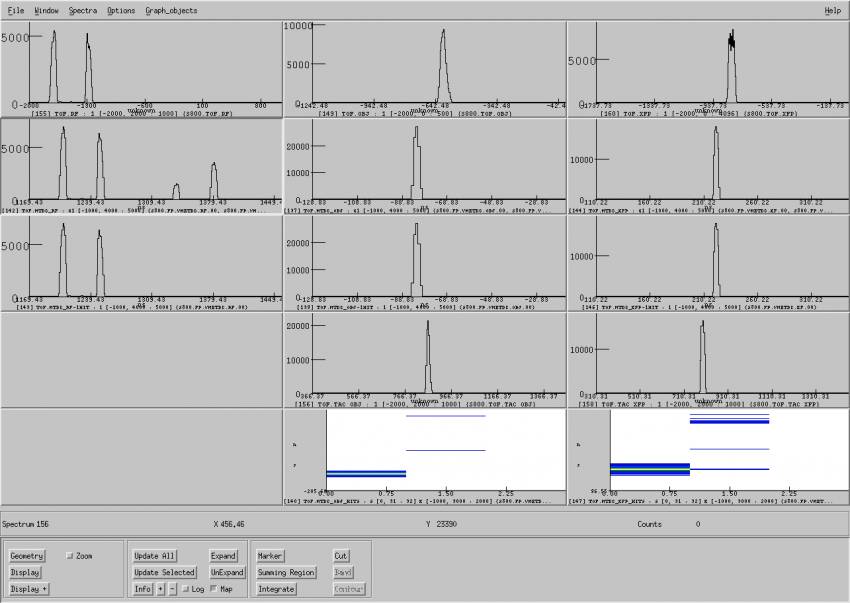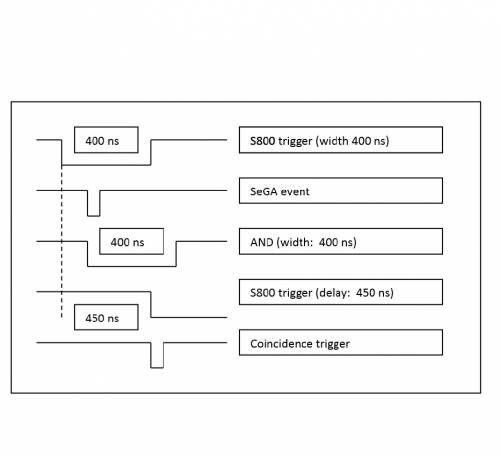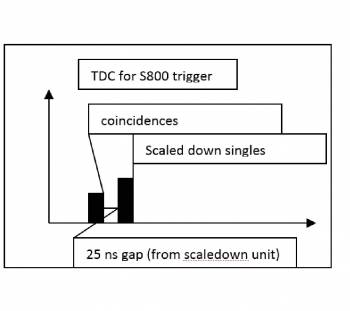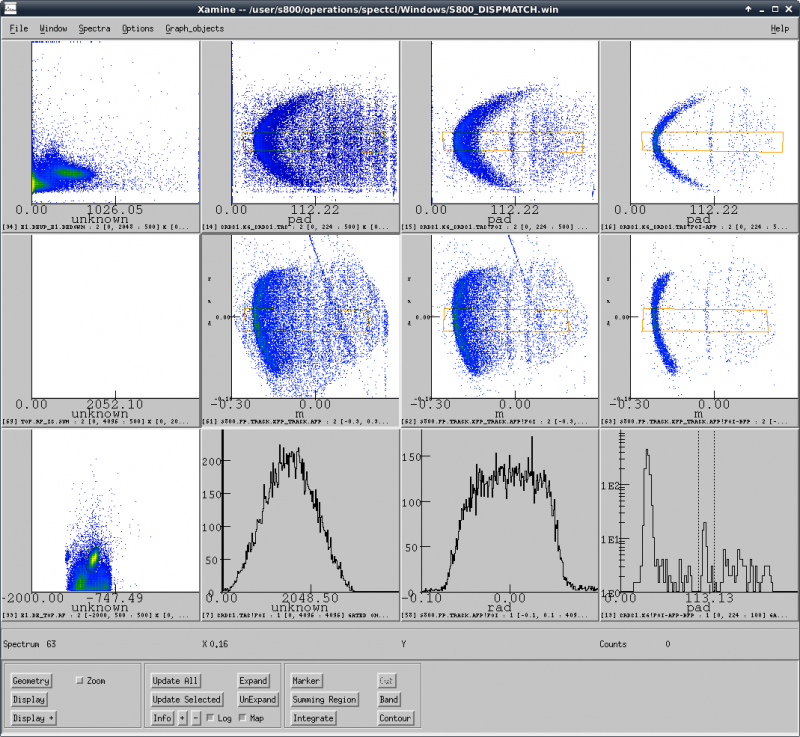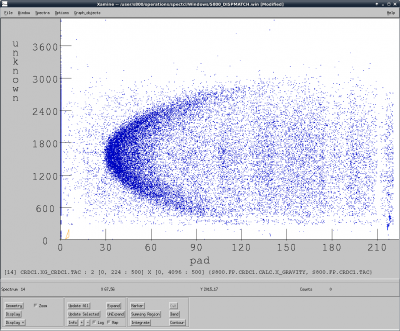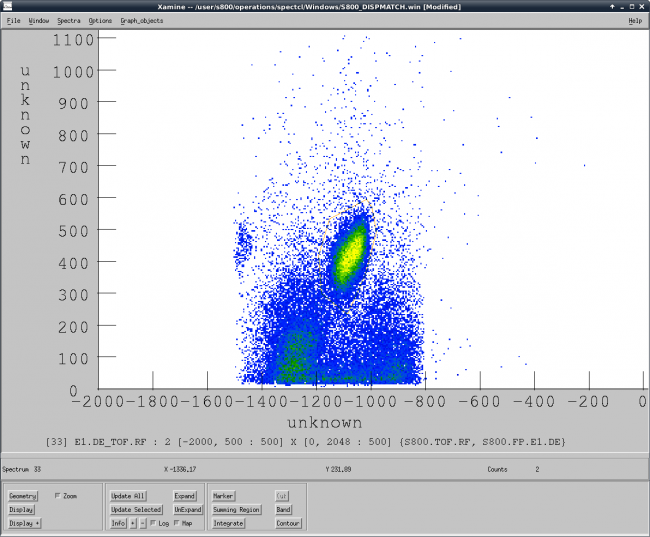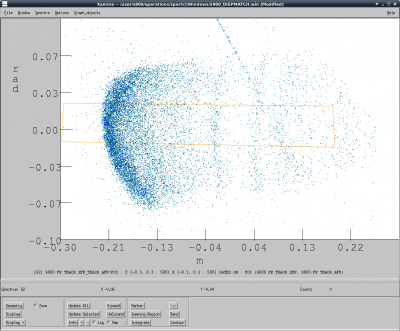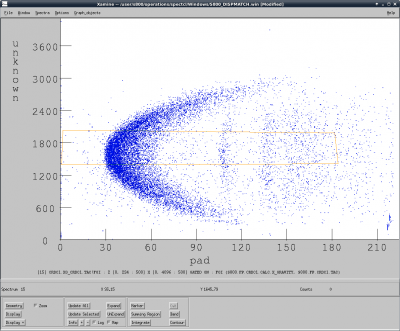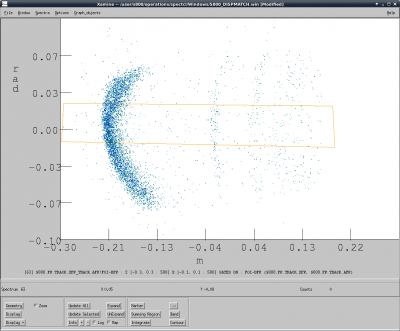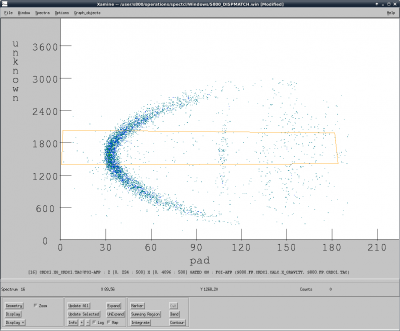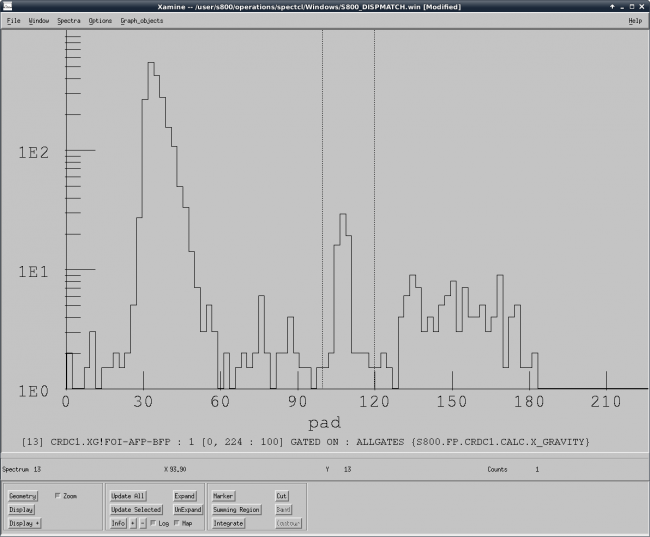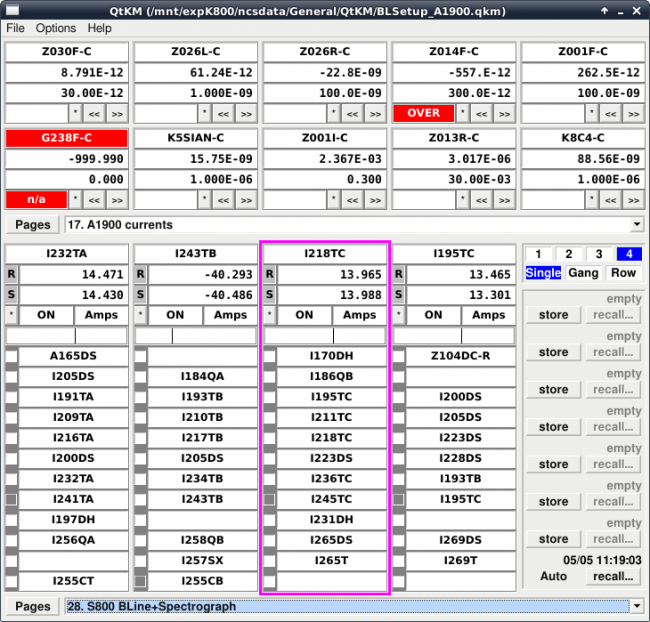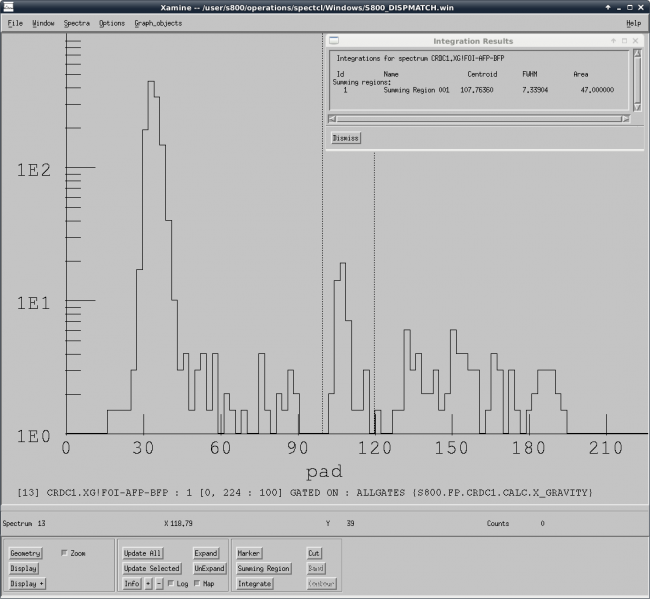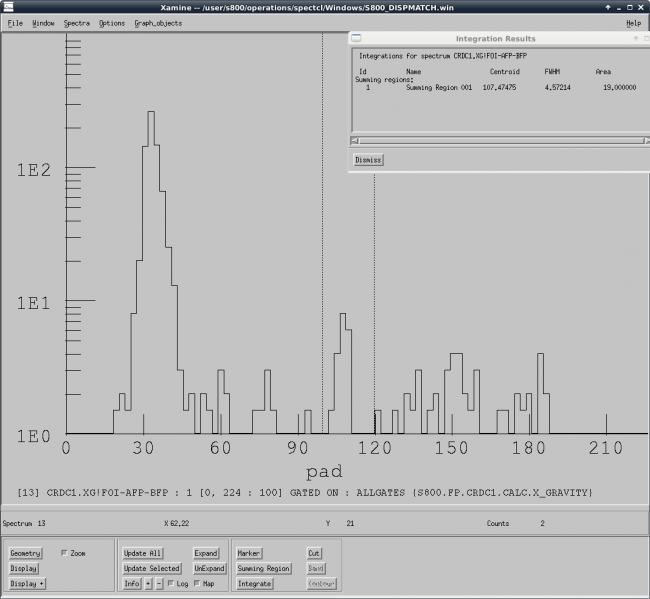This is an old revision of the document!
Table of Contents
S800 Tuning (XDT)
This page gives the steps that are followed when tuning the S800. The two possible tuning modes are included, namely, the Focus mode and the Dispersion-matching mode.
Before proceeding, it is mandatory to complete all the steps of the to-do list necessary to prepare the S800 for tuning. The preparation of the S800 for tuning is covered by the A1900 prior to every experiment.
Focus Mode
For most of the experiments in the S800, the analysis line is run in focus mode. In this optics, the analysis line is achromatic, i.e. the dispersive position of the beam focused in the target area (pivot point) does not depend on the momentum. Thus, this mode provides the biggest momentum acceptance (4%). On the other hand, since the spectrograph focal plane is chromatic, the resolution is limited to about 1 part in 1000 in energy.
Unreacted beam
In the first part of the XDT, the rigidity of the S800 is typically set to match the value of the fragment beam (selected in the A1900) after passing through the S800 target. This is where the term “unreacted beam” comes from.
Send beam to FP
- Ensure that the S800 spectrograph magnets are tuned to the right rigidity
- Verify that the beam blocker (labeled I255 Slits) in the S3 page of Barney is open:
- Expected “open” values for top and bottom slits are CT ~6.8 and CB ~3.2, respectively
- Ensure that CRAD04 (typically connected to object scintillator) is enabled with a rate limit of 20 kHz (CRAD04 looks at E1 up FP scintillator)
- Remember: S800 FP rate limit is 6 kHz
- Bias S800 FP scintillator photomultipliers
- Set bias to best guess based on previous experience for the fragment Z being used (bias will be adjusted later during tuning)
- Typical values from previous experiments:
- For He-3 @ ~130 MeV/u: UP (1790 V); DOWN (1760 V)
- For Be-12 @ ~30 MeV/u: UP (1770 V); DOWN (1700 V)
- For Ar-34 @ ~80 MeV/u: UP (1580 V); DOWN (1510 V)
- For Zn-58 @ ~44 MeV/u: UP (1400 V); DOWN (1340 V)
- For U-238 (88+) @ ~70 MeV/u: UP (1180 V); DOWN (1280 V)
- Have a good expectation of rate from A1900 group information or from timing scintillators (typically XF_SCI: extended focal-plane detector)
- Remove stops to look for beam at S800 FP with scalers and adjust beam rate with attenuators
- Look at FP scintillator scalers (E1 up, E1 down)
- There are typically a few scaler counts without beam
Object scintillator setup
- Bias detector. Typical bias: 1200-1800 V (up to 2200 V)
- Use scope to look at signal patched out to data U6 (channel #54 in data U6 patch panel)
- This signal is sent to the CANBERRA 454 Quad CFD in data U6
- One of the output from this CFD is sent (via patch panel #62) to the TAC and scaler (channel OBJ.Scint) in S3. The other output goes through a passive delayed, and is sent (via patch panel #67) to the Phillips TDC
- Check raising time and amplitude. Good signal: ~10 ns raising time; 400-500 mV amplitude
- Using the scope, check the CFD setting:
- Check CFD walk inspect signal in scope by triggering scope with CFD output
- Ensure that CFD delay cable is ok: about 80% of raising time of the input signal
- Adjust CFD threshold looking at scalers. The ratio of OBJ to XFP scaler rates (channels OBJ.Scint and XFP.Scint) should reflect the transmission of the cocktail beam
- Adjust MCFD threshold:
- Open configuration file MCFD16.tcl in /user/s800/operations/daq/usb/Configs
- The OBJ signal feeding this module is not patched out to data U6
- The OBJ signal from MCFD-16 module goes to the Mesytec MTDC32 module and scaler (channel OBJ.MCFD.Scint)
- Make sure that the threshold of the XFP MCFD channel is reasonable. Rates in scaler channels XFP.Scint and XFP.MCFD.Scint should be comparable
- Adjust MCFD OBJ threshold looking at scalers. The ratio of OBJ to XFP scaler rates (channels OBJ.MCFD.Scint and XFP.MCFD.Scint) should reflect the transmission of the cocktail beam
- Save new threshold in configuration file MCFD16.tcl
- Watch for no rate change on scaler display with a bias adjustment up or down of about 50-100 V
FP scintillator setup
- Set trigger to “s800 trigger”
- Ensure that the trigger GUI application is ready. Otherwise, open it by clicking button Launch ULM GUI in ReadoutGUI
- Under trigger tab select s800 trigger (which is E1 up by definition)
- Deselect experiment trigger
- SAVE TO FILE
- End and Begin ReadoutGUI to assert new trigger condition
- Select Spectcl window S800_SCINT.win
- Adjust bias looking at 2D spectra e1.deup_e1.dedown (showing the parameters s800.fp.e1.de_down vs. s800.fp.e1.de_up) for the FP E1 scintillator
- See spectrum below. Changing bias of this detector stretches the curve (i.e. shifts the blob in the middle of the curve corresponding to typical unreacted beam)
- Adjust biases so that unreacted beam are at 1/3 to 1/4 of dynamic range
- Reaction product will typically be similar enough to unreacted beam particles
- Different particles with different energy loss will shift the curve corresponding to particles covering whole FP
Ionization Chamber setup
- Gas should be flowing
- Bias detector
- Typical bias Anode: 200 V (should not draw current after bias is reached)
- Select Spectcl window S800_IC.win
- Adjust pad gains
- There are 16 pads each providing energy-loss information in the beam direction
- The idea is to make sure the dynamic range is OK so that heavy particles do not saturate the spectra; the pad gains do not have to be matched
- Use summary 2D spectra IC.raw (see spectrum below)
- Gains are controlled in s800shpini.tcl file in directory s800/operations/daq/usb/Configs (an example of the content of this file can be seen here).
- First shaper is for ion chamber
- Typically, only coarse gains are used
- End and Begin ReadoutGUI to assert new gain values
CRDCs setup
- Bias CRDCs
- Look at anode signal on scope while biasing drift and anode
- Patched to data-U6 on labeled connector
- 200 – 500 mV signals are good
- CRDC1 anode is noisier (digital noise) than CRDC2
- Bias CRDC1 and CRDC2. Typical starting values:
- For He-3 @ ~130 MeV/u: CRDC1 (Anode=1120 V, Drift=1000 V); CRDC2 (Anode=1120 V; Drift=1000 V)
- For Be-12 @ ~30 MeV/u: CRDC1 (Anode=970 V, Drift=1000 V); CRDC2 (Anode=970 V; Drift=1000 V)
- For Ar-34 @ ~80 MeV/u: CRDC1 (Anode=860 V, Drift=1000 V); CRDC2 (Anode=840 V; Drift=1000 V)
- For Zn-58 @ ~44 MeV/u: CRDC1 (Anode=740 V, Drift=1000 V); CRDC2 (Anode=740 V; Drift=1000 V)
- For Rb-74 @ ~40 MeV/u: CRDC1 (Anode=650 V, Drift=1000 V); CRDC2 (Anode=650 V; Drift=1000 V)
- For U-238 (88+) @ ~70 MeV/u: CRDC1 (Anode=570 V, Drift=1000 V); CRDC2 (Anode=570 V; Drift=1000 V)
- Gate bias: ~20-30 V (adjust to optimize signal height compared to noise)
- Should see counts on scalers
- Count rate is a little higher than on scintillator due to noise or thresholds
- Check Spectcl window S800_CRDCS.win (see figure below) to verify the good performance of the detectors. (The spectra for each CRDC can be checked separatelly in windows s800_CRDC1.win and S800_CRDC2.win)
- Spectra crdc1.raws and crdc2.raws (top and middle spectra in the leftmost (first) column)
- Each spectra shows the multiple sampled signals from each pad
- The 224 pads are assembled along the dispersive direction
- Width of beam peak is proportional to A1900 p-acceptance in focus optics
- Width is narrower in match optics
- Adjust anode HV to bring fuzzy maximum to around 600-700 channels (saturation of each pad at ~ 1000 ch)
- Spectra crdc1.anode_crdc1.tac and crdc2.anode_crdc2.tac (top and middle spectra in the second column)
- This spectrum is used to ensure that the field in the detectors is uniform and well aligned. If the detector is working properly, then the amplitude of the ANODE signals should not depend on the position of the beam (as shown in the figure below)
- If the field is not well aligned, then there will be a correlation between ANODE signals and TAC signals
- Spectra crdc1.x_crdc1.padsum and crdc2.x_crdc2.padsum (top and middle spectra in the third column)
- It shows the sum over multiple sampled signals from each pad along the (dispersive) x position
- The padsum signals should not show any correlation with the x (dispersive) position
- Spectra crdc1.xg_crdc1.tac and crdc2.xg_crdc2.tac (top and middle spectra in the fourth column)
- It shows the beam distribution in the dispersive (xg) vs non-dispersive (tac) directions
- It is used to ensure that the fragment beam is centered in the detectors
- It is also used to see the effect of the beam blocker (used to stop intense contaminants) in the cocktail beam
- Spectra crdc1.xg and crdc2.xg (bottom spectra in first and second columns)
- It shows the position of the beam in the dispersive direction, evaluated by calculating the “center of gravity”. The peak should be in the middle of the spectra in order to center the beam
- Spectra crdc1.tac and crdc2.tac (bottom spectra in third and fourth columns)
- They correspond to the non-dispersive position of the beam in the CRDCs.
Timing setup
At present, there are three electronic “sources” with time information for ToF calculation: ORTEC TACs, Phillips TDC, and Mesytec MTDC. Some background information can be found here.
- Select SpecTcl window S800_TOF.win
- Make sure that the time range of spectra is wide enough (e.g. between -3000 to 3000)
- The three columns correspond to the RF-FP ToF (left), OBJ-FP (center), and XFP-FP (right)
- The first (top) row corresponds to the Phillips TDC
- The second row corresponds to the MTDC with all the hits included
- The third row corresponds to the MTDC with only the first hit
- The fourth row corresponds to the ORTEC TACs. Note that there is not RF-FP TAC
- The two spectra in the fifth row corresponds to the MTDC summary spectra of OBJ-FP and XFP-FP ToFs (zoomed in). The spectra show the ToF (vertical axis) vs. hit number (horizontal axis). In an unreacted setting, one expects to see the most of the “good” ToF peak recorded in the first hit
- Although the ToF reference (“start”) in all the ToF modules is given by the FP scintillator E1 up, the electronic path from the detector to each module is different (see main electronics diagram for more details)
- Before going to the ToF modules, the OBJ and XFP signals are sent to a CANBERRA CFD 454 CFD in data U6 from the data-U6 patch panel (OBJ: patch panel #54, XFP: patch panel #1). (The exception is the OBJ signal into the MTDC)
- MTDC:
- Before getting into the MTDC, the OBJ, XFP, and E1 up signals in the MTDC go through a Mesytec MCFD
- The OBJ signal into the MCFD comes directly from the detector via S3 patch panel #94 (i.e., there is no signal to check in data U6)
- The XFP signal into the MCFD module comes from data-U6 patch panel #70, connected to the CANBERRA 454 CFD XFP output
- SpecTcl calculates the OBJ-to-Focal-Plane and XFP-to-Focal-Plane ToFs by substracting the E1 up time (MTDC channel 15) to the OBJ time (MTDC channel 3) and the XFP time (MTDC channel 2)
- The MTDC timing signals do not require external delay adjustments because the matching window is sufficiently wide
- Tennelec TACs:
- The OBJ stop signal to the “OBJ-to-Focal-Plane” TAC is sent from the CANBERRA 454 CFD OBJ output via patch panel #62.
- The XFP stop signal to the “XFP-to-Focal-Plane” TAC is sent from the CANBERRA 454 CFD OBJ output via patch panel #70.
- Phillips TDC:
- The OBJ output signal from the CANBERRA 454 CFD is delayed with the low-noise delay boxes in data-U6, and sent to the TDC via patch panel #67
- The XFP output signal from the CANBERRA 454 CFD is delayed with the low-noise delay boxes in data-U6, and sent to the TDC via patch panel #66
- SpecTcl calculates the OBJ-to-Focal-Plane and XFP-to-Focal-Plane ToFs by substracting the E1 up time (channel 8) to the OBJ time (channel 14) and the XFP time (channel 15)
- The TDC start is sent from the ULM trigger module. Since the delay of the S800 trigger may be adjusted during XDT, the stop signals (e.g. from OBJ or XFP) will need to be re-adjusted.
- Examine the timing of each of the selectable listed signals with respect to the “Live Trigger” signal
- There are 4 TDC inspect channels patched to data-U6 that can be assigned using the trigger GUI
- The full range of the TDC is 400 ns
- Set each timing to 200 ns
- TDCs of last 4 listed signals (including XF and object scintillators) are bypassed with cable delays inside the vault and thus their delays cannot be controlled with the GUI
- They can be inspected, however using the GUI
- The TDC delays can only be changed when the run control is stopped; must SAVE settings before starting run control not to overwrite adjustments being made
- Trigger the scope with the “Live Trigger” signal patched to data-U6
- There are 4 trigger inspect channels patched to data-U6 that can be assigned using the trigger GUI
- Examine the timing of each of the selectable listed signals with respect to the “Live Trigger” signal
- There are 4 TDC inspect channels patched to data-U6 that can be assigned using the trigger GUI
- The full range of the TDC is 400 ns
- Set each timing to 200 ns
- TDCs of last 4 listed signals (including XF and object scintillators) are bypassed with cable delays inside the vault and thus their delays cannot be controlled with the GUI
- They can be inspected, however using the GUI
- See http://groups.nscl.msu.edu/s800/Technical/Electronics/Electronics_frameset.htm for background information on the trigger setup
- The TDC delays can only be changed when the run control is stopped; must SAVE settings before starting run control not to overwrite adjustments being made
- The “S800” trigger is from E1 up signal
- Trigger the scope with the “Live Trigger” signal patched to data-U6
- There are 4 trigger inspect channels patched to data-U6 that can be assigned using the trigger GUI
- Examine the timing of each of the selectable listed signals with respect to the “Live Trigger” signal
- There are 4 TDC inspect channels patched to data-U6 that can be assigned using the trigger GUI
- The full range of the TDC is 400 ns
- Set each timing to 200 ns
- TDCs of last 4 listed signals (including XF and object scintillators) are bypassed with cable delays inside the vault and thus their delays cannot be controlled with the GUI
- They can be inspected, however using the GUI
- Information
- The signal delays controlled by the GUI (and not by cable delays) are not “pipelined” -– i.e., any new signals that arrive during the delay time of a previous signal are lost and thus deadtime is introduced into the system. The signals delayed passively by cables are “pipelined” and thus are not subject to deadtime losses
- All of the trigger signals are not pipelined and are thus subject to deadtime
Checking Particle ID and rate at S800 FP
- Establish PID
- Refer to information on setting from A1900 FP
- dE-TOF
- dE signal from Ion Chamber
- TOF from XF or Object scintillator to S800 FP
- Not necessary to implement dE- or TOF-based corrections
- Document rate of fragment of interest with run to disk
- Measure beam current with appropriate Faraday cups
- Timed run
Analysis line classic PPAC setup (Focus optics only)
- “Classic” PPACs are the default detector, not TPPACs or CRDCs
- Classic PPACs have rate limitations from pileups
- TPPACs are not as efficient as CRDCs for low Z because it is not currently setup to set thresholds on individual pad readouts
- Checking PPACs with beam
- Scalers do not provide reliable diagnostic information because of noise
- Bias PPACs while looking at patched out anode signal on scope to check for sparking
- Typical starting value: 400V
- A sample HV sample for 48K @ 95 MeV/u biases: PPAC1=580V, PPAC2=540V
- Look at spectra of raw up, down, left, right, anode to decide on bias
- Run with smaller p-acceptance (e.g., 0.5%)
- Efficiency against Focal plane CRDCs should be 100%
- Optimize bias setting based on raw signals
- Check that position spectra look reasonable
- Run with larger p-acceptance (e.g., 2%)
- Efficiency against Focal plane CRDCs should be 100%
- Record run showing tracking
- Confirm angular dispersion: ~50 mrad/% (not an absolute measurement)
- Confirm correlations between dispersive angle at intermediate image and p in FP (e.g., crdc1x). This correlation will be somewhat washed out by straggling in the target; in principle, this should be checked without the target, but the benefit vs. cost in time to remove the target is not worth it.
Setup beamline
- Object and XF scintillators and intermediate image PPACs inserted if they will be used
- If Object scintillator will not be used, there is no reason to look at beam on it unless to debug a problem with the transmission
- Set spectrograph Brho for unreacted fragment
Start scalers
- Use s800 account
- Make sure experiment daq is:
- Stopped
- Gone
- Open terminal window (from bottom of mac)
- ssh to spdaq20
- ps auw | grep Readout
- Does not get restarted
- Under operations folder on mac
- scalers (gives error if no bridge)
Setting Optimization
Focused optics
- Expectations for A1900 FP to S800 FP transmission
- 80% or better for mid-Z fragments
- >60% for low-Z fragments with large angles
- 40% transmission might be a cause for concern for high-Z beam with charge state losses in detectors/targets depending on the charge state distribution and how many charge states reach the S800 FP
- Strategy for optimizing transmission
- Want to balance losses between S800 analysis line and Transfer Hall (the S800 analysis line is typically slightly worse)
- Best diagnostic is scalers from S800 FP, object scintillator and XF scintillator
- Tweak y-quads (while watching scalers) in front of dipole gaps (this works both for Transfer Hall and analysis line); choose elements that have biggest effect with smallest ratio change
- Document optimized transmission with another run to disk to measure rate of fragment of interest at S800 FP
Matched optics
- Typically much more time is invested for optimizing optics for matched optics than for focused optics
- One input is optimizing for transmission
- For tritons a scintillator is required at the pivot position since fragments at 5 Tm will not reach S800 FP
- The last two analysis line triplets are used to tweak for the desired optical properties
- Document optimized transmission with another run to disk to measure rate of fragment of interest at S800 FP
Reaction Setting
Setting up Reaction Settings
- Calculating reaction setting
- Center unreacted beam at S800 FP
- Adjust spectrograph Brho to center beam at S800 FP
- Requirements for a beam to be “Centered”
- Spectrograph dipoles matched
- Beam position within about 1 cm of center as judges by 0 point on crdc1x spectrum or on track.xfp spectrum
- Record run to disk to document centered unreacted beam setting
- Calculate reaction setting using “effective” beam energy and the nominal target thickness
- Ideally, experimenters should be the ones making this calculation
- This approach assumes that the target thickness is known
- Reaction setting to FP
- Start with Attenuator setting of unreacted beam and step up in intensity
- Set up beam blocker, if necessary
- Expect to see unreacted beam if reaction setting is within +/- 3% of unreacted beam setting
- Should have to move only one of the two blockers unless charge states are present
- A graphic tool is available to help (not yet calibrated)
- Try to cut only as much as necessary; depends on
- What rate limits allow
- What experimenters want (e.g., if they want singles, the cut has to be more restrictive to limit acquisition deadtime)
- Move blocker, decrease attenuator, repeat
Coincidences
- Overview
- Most experiments at the S800 involve setting up an auxiliary detector system (e.g. SeGA, HiRA, etc) to be used in coincidence with the standard detectors of the S800.
- The auxiliary detector provides a secondary trigger that is fed into the S800 trigger system
- A key part of setting up the S800 for such experiments is getting proper timing setup between the S800 and any auxiliary detectors
- For cases where the Secondary detector has a slow response relative to the S800, the coincidence timing must be reset to the S800 timing by delaying the S800 trigger using the third gate and delay generator on the trigger GUI
- A typical S800 delay for SeGA is 450 ns
- Probably smaller typical S800 delay needed for HiRA
- An example of experiments where auxiliary detectors are not used and, thus, setting up coincidence timing is not an issue are the experiments with tritons run by the charge exchange group
- It is not clear whether coincidence setup gets logged as “XDT” or “EXR”
- Choice of setting to be used for coincidence timing setup
- The reaction of interest for the experiment can be used to setup coincidences only if the rate of coincidences is high enough
- Sometime the pilot beam is used for setting up the coincidence timing in cases where the intensity of the secondary beam is too small
- Example: Reaction of interest 2p knockout to make Mg-36 from Si-38 (Si-38 rate was 1000 pps)
- Setup
- Coincidence signals are usually visible on scope without running scope in acquire mode
- Adjust the width of the early signal (S800 or secondary) should be wide enough to catch coincidences with the late signal (width of late signal is not critical)
- Readjust TDC delays based on changes made to S800 trigger delay
- Experimenters will need to adjust their delays based on delay made to S800 trigger
- Have experimenters record a run with coincidences on their account
- S800 trigger TDC channel should show a peak (which corresponds to coincidences)
- “secondary” TDC channel should have a peak
- This check is required for verification in cases of low beam intensity (e.g. 1000 pps)
- Length of run required is typically about 10-15 minutes
- To be resolved: whether or not to this run copied from experiment account for documentation of device tuning
- Sample timing for running S800 with SeGA
- SeGA trigger is late with respect to S800 trigger
- The figure below represents a timing schematic to show how to
- Setup of the S800 trigger to recover timing needed for proper functioning of S800 FP detectors
- Set up the coincidence trigger
- A double peak structure will appear in the TDC for the S800 trigger between the coincidence events and the singles events (see figure below); the groups are separated by 25 ns because of the delay introduced by the downscaler used for the singles
Follow-up
- Before leaving beam with experimenters
- Set up current trip points on Linux HV controls
- Values used for K-48
- 5 for CRDC and Ion Chamber anodes and intermediate image ppacs
- 50 for CRDC drifts
- 80 for IC drift
- Ensure alarms are running
- Make sure Linux HV GUI alarms are enabled
- Make sure threshold on isobutane level is set up (not currently connected to alarms because they give too many false alarms when communication is lost)
- All logs are being recorded
- There is no log file for biases controlled by Labview
- Linux HV
- LabView gas handling system
- Note in logbook
- Scintillator biases
- IC gate biases
- Post reference printouts for experimenters
- HV status: a snapshot of HV GUI
- Gas handling system status: a snapshot of LabView window
- Create window configuration with summing regions to make it easier for experimenters to track efficiency/performance of all detectors
- Setting up coincidences for additional reaction settings in an experiment
- Do not need to redo coincidence settup if secondary beam does not change
- Might need to redo coincidence setup if secondary beam changes drastically
- To watch during experiment
- Look for isobutene running out – messes up data over several hours
- Implementing dE- or TOF-based corrections is part of EXR
More detail needed
Minimum rates required for coincidence setup Selection of appropriate substitute reactions for coincidence setup How to feel comfortable that there will not be a problem with FP detector gases running out Starting alarms Starting logging
Dispersion Matching tuning
In the dispersion-matching optics, the S800 focal point is achromatic, i.e. the position of the beam in the dispersive direction does not depend on the momentum. As a consequence, the beam is momentum-dispersed on the target area (pivot point) with a dispersion of about 10 cm/%. The main goal of the tuning is to ensure that the position and angle dispersion are cancelled at the focal plane, thus maximizing the resolution at that point. We also want a good image in the object position, which will also contribute to increase the resolution at the focal plane.
Charge-exchange experiments require typically this optics. In some cases, the beam used is 3H, which has a rather high rigidity (around 4.8 Tm). This imposes a serious constrain, because the maximum rigidity of the spectrograph is 4 Tm. Thus, in this case, the tuning of the S800 is done with 3He, produced with a CH2 target.
- Set trigger to “s800 trigger”
- Ensure that the trigger GUI application is ready. Otherwise, open it by clicking icon RunControl in the desktop of u6pc5 computer
- Under trigger tab select s800 trigger (which is E1 up by definition)
- Deselect experiment trigger
- SAVE TO FILE
- Stop and start RunControl to assert new trigger condition
- Select Spectcl window S800_DISPMATCH.win
- We need to start checking the spectra showing the correlations between angle and position in both dispersive and non-dispersive directions. We typically use the spectrum CRDC1.XG_CRDC1.TAC for the non-dispersive direction, and S800.FP.TRACK.XFP_TRACK.AFP for the dispersive direction
- The parabolas seen in the above spectra correspond to reactions with H in the target. The blurred lines on the right of the parabolas correspond to reaction with C. It is hard to see clearly this lines, so we need to make several gates
- Open spectrum E1.DE_TOF.RF and define a gate around 3He, and call it foi (Fragment Of Interest). (Note that unlike other experiments, where the energy loss is measured by the IC, we use here the E1 sinctillator.
- This gate is used to fill spectra S800.FP.TRACK.XFP_TRACK.AFP!FOI and CRDC1.XG_CRDC1.TAC!FOI. As can be seen in the figures below, this gate “cleans” the spectra significantly. Indeed, one can now see the lines from reaction with C; the leftmost one corresponds to the ground-state, the next one to the right is the first excited state
- Define rectangular gates in this spectra, making sure that it is narrow enough to select a vertical section of the parabolas, but wide enough to get enough statistics. Call them afp (in spectrum CRDC1.XG_CRDC1.TAC!FOI) and bfp (in spectrum S800.FP.TRACK.XFP_TRACK.AFP!FOI). After applying these new gates, the kinematics spectra are very clean
- The pre-defined gate allgates is made by the AND condition of all the gates defined above (foi, afp, and bfp). This gate is used to fill the spectrum CRDC1.XG!FOI-AFP-BFP, which will be our diagnostics tool
- The leftmost peak corresponds to reactions with H. The central peak are reaction with C. The goal of the tweak is to make these peaks as narrow as possible
- Open the NCS application QtKM in the Applications Menu. Open file BLSetup_A1900.gkm. The magnetic elements that are typically tweaked with the knob box seating on the left side of u6pc5 are I232TA, I236TC, and I245TC which can be found on page S800 BLine+Spectrograph. Other elements used to improve the focusing in the object point, and the transmission are I172QA and I174QB. The goal of the dispersion-matching tuning is to find a compromise between transmission and resolution.
- The two figures below show the spectrum CRDC1.XG!FOI-AFP-BFP before (top) and after (bottom) the dispersion-matching tuning for a typical experiment. Be aware that the width given by SpecTcl for the selected peak is not too reliable. It is more convenient to do a real gaussian fit. Unfortunatelly this is not an option included in the current version of SpecTcl. That's why some device physicists prefer SpecTk for this type of tuning

